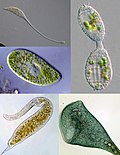Paramecium (/ˌpærəˈmiːs(i)əm/ PARR-ə-MEE-s(ee-)əm, /-siəm/ -see-əm, plural "paramecia" only when used as a vernacular name) is a genus of eukaryotic,...
30 KB (3,181 words) - 01:33, 21 October 2024
Paramecium caudatum is a species of unicellular protist in the phylum Ciliophora. They can reach 0.33 mm in length and are covered with minute hair-like...
7 KB (657 words) - 16:52, 18 September 2024
Paramecium aurelia are unicellular organisms belonging to the genus Paramecium of the phylum Ciliophora. They are covered in cilia which help in movement...
11 KB (1,195 words) - 01:28, 24 September 2024
Paramecium bursaria is a species of ciliate found in marine and brackish waters. It has a mutualistic endosymbiotic relationship with green algae called...
4 KB (325 words) - 07:56, 14 June 2024
Paramecium woodruffi is a species of unicellular organisms belonging to the genus Paramecium of the phylum Ciliophora. It was first isolated in 1928 by...
1 KB (71 words) - 16:21, 15 April 2024
ParameciumDB is a database for the genome and biology of the ciliate Paramecium tetraurelia. Paramecium Arnaiz, Olivier; Cain Scott; Cohen Jean; Sperling...
1 KB (61 words) - 15:59, 11 January 2022
Paramecium sonneborni is a species of unicellular organisms belonging to the genus Paramecium of the phylum Ciliophora. It was first isolated in Texas...
3 KB (285 words) - 14:43, 14 April 2024
Paramecium biaurelia is a species of unicellular ciliates under the genus Paramecium, and one of the cryptic species of Paramecium aurelia. It is a free-living...
10 KB (1,061 words) - 16:52, 18 September 2024
Autogamy (section Paramecium aurelia)
environments. Paramecium aurelia is the most commonly studied protozoan for autogamy. Similar to other unicellular organisms, Paramecium aurelia typically...
21 KB (2,439 words) - 16:50, 29 July 2024
amplification in Paramecium tetraurelia is an example of gene amplification that has occurred in the unicellular organism Paramecium tetraurelia. Gene...
5 KB (741 words) - 22:04, 13 February 2024
mechanism is unknown. After a certain number of generations (200–350, in Paramecium aurelia, and as many as 1,500 in Tetrahymena) the cell shows signs of...
34 KB (3,421 words) - 11:58, 24 October 2024
by heterotrophy. Traditional textbook examples of protozoa are Amoeba, Paramecium, Euglena and Trypanosoma. The word "protozoa" (singular protozoon) was...
52 KB (5,212 words) - 05:40, 27 October 2024
American biologist. His life's study was ciliated protozoa of the group Paramecium. Sonneborn attended the Baltimore City Public Schools and graduated from...
11 KB (1,209 words) - 10:26, 18 October 2024
different ways of preventing cytolysis from occurring. For example, the paramecium uses a contractile vacuole, which rapidly pumps out excessive water to...
4 KB (254 words) - 06:05, 7 November 2024
cylindrical cells, bacteria, on left) and a single-celled eukaryote, Paramecium Coast redwood Blue whale The eukaryotes are a diverse lineage, consisting...
61 KB (6,102 words) - 11:22, 19 October 2024
neck) and inguinal (in the groin) lymph nodes. The single-cell eukaryote Paramecium tetraurelia can undergo both asexual and sexual reproduction. Asexual...
9 KB (1,040 words) - 13:27, 6 November 2024
longer. The best-understood contractile vacuoles belong to the protists Paramecium, Amoeba, Dictyostelium and Trypanosoma, and to a lesser extent the green...
10 KB (1,304 words) - 12:50, 2 July 2024
amoeba and paramecium. Amoeba Amoeba uses pseudopodia to capture food for nutrition in a process called phagocytosis. Paramecium Paramecium uses cilia...
5 KB (540 words) - 14:49, 29 June 2018
visible bodies after artificial stimulation. Filamentous trichocysts in Paramecium and other ciliates are discharged as filaments composed of a cross-striated...
3 KB (300 words) - 22:11, 13 January 2024
Holospora is an intracellular parasite found in the unicellular protozoa Paramecium. Draft genome sequences are available for three Holospora species and...
4 KB (257 words) - 07:47, 14 June 2024
group of protists that utilize cilia for locomotion. Examples include Paramecium, Stentors, and Vorticella. Ciliates are widely abundant in almost all...
33 KB (3,362 words) - 09:06, 30 October 2024
Paramecia (an extinct red alga) is also the plural of the name of the genus Paramecium (which is in the SAR supergroup), which can also lead to confusion. A...
27 KB (3,079 words) - 21:02, 8 November 2024
cytoplasmic symbionts, occurring in some strains of the ciliate Paramecium. Paramecium strains possessing the particles are known as "killer paramecia"...
4 KB (394 words) - 19:13, 24 September 2023
movement of paramecium. This helps the cell avoid obstacles and causes other objects to bounce off of the cell's outer membrane. The paramecium does this...
2 KB (206 words) - 10:20, 2 August 2024
experiments on the single-celled green alga, Chlamydomonas reinhardtii, using paramecium as a predator. They found that in the presence of this predator, C. reinhardtii...
43 KB (4,820 words) - 05:23, 3 November 2024
"outside" and πλάσμα plasma, "anything formed." Cytoplasm Endoplasm "Paramecium Coloring". www.biologycorner.com. Retrieved 23 April 2018. Arthur C. Guyton...
2 KB (145 words) - 00:50, 11 May 2024
sequence of the ciliate Paramecium caudatum reveals a shift in nucleotide composition and codon usage within the genus Paramecium". BMC Genomics. 12: 272...
26 KB (2,664 words) - 03:34, 2 November 2024
gametes. A few types of organisms, such as many fungi and the ciliate Paramecium aurelia, have more than two "sexes", called mating types. Most animals...
34 KB (3,768 words) - 21:40, 10 November 2024
their genes collaborating to manipulate the host Unicellular organism Paramecium One cell, with organelles e.g. cilia for specific functions Yes Inter-cellular...
25 KB (2,323 words) - 19:58, 5 November 2024
the end with a mouth (or equivalent structure, such as the cytostome in Paramecium or Stentor), or the end that usually points in the direction of the organism's...
45 KB (5,283 words) - 15:41, 7 November 2024


















